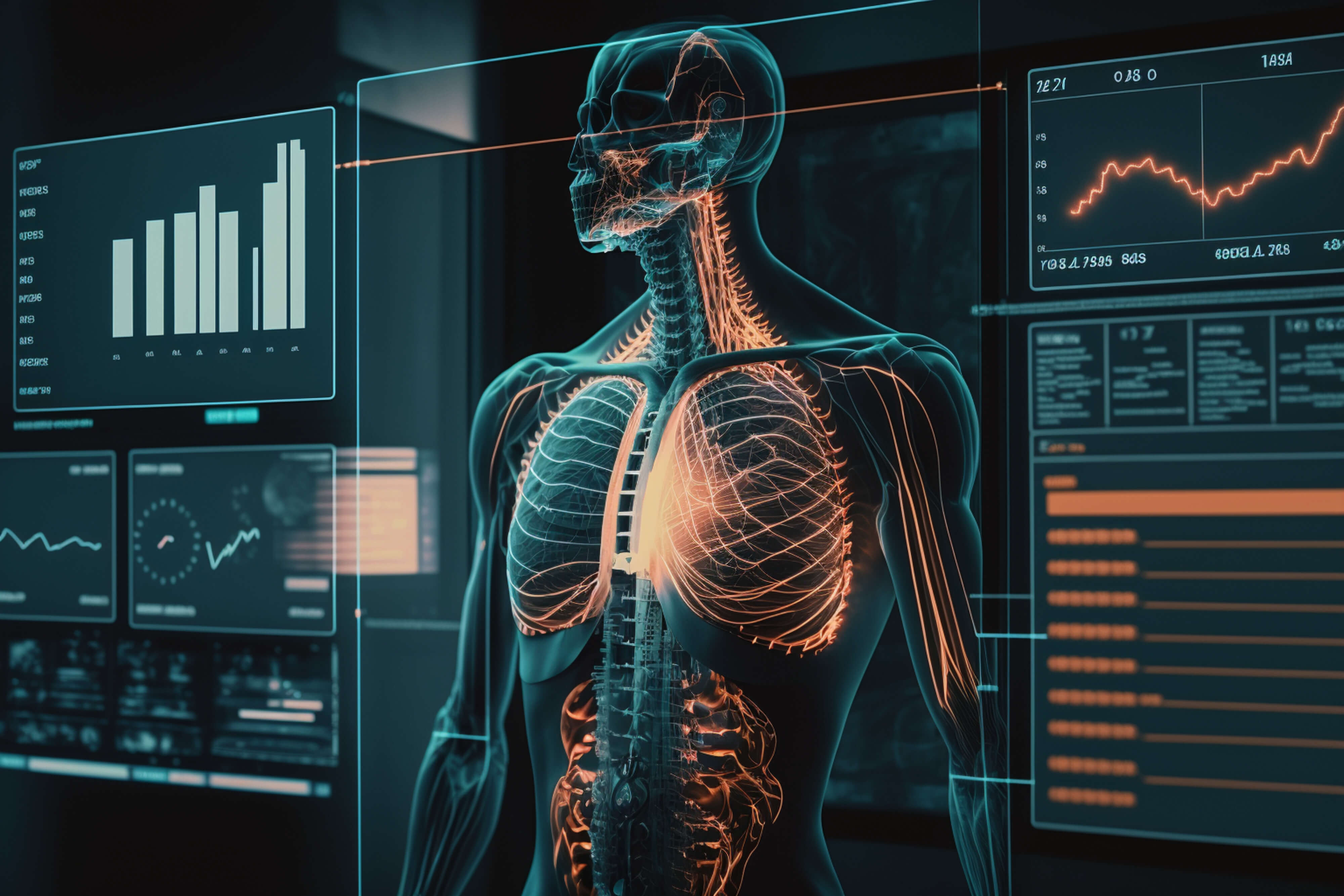Artificial Intelligence | Healthcare
Demystifying Natural Language Processing (NLP) for the Healthcare Industry
Read Time 8 mins | Written by: Anuj Kharnal

Machine Learning (ML) in healthcare is a subset of artificial intelligence (AI) that involves the use of algorithms and statistical models to analyze large datasets and learn patterns, trends, and associations from the data. ML algorithms in healthcare can make predictions, classify data into different categories, and assist in decision-making processes. ML applications in healthcare have the potential to enhance diagnostics, treatment planning, patient monitoring, and various other aspects of healthcare delivery.
2. Tools and Technologies for ML
3. Applications of ML-based models in the healthcare industry
How does ML work?
ML works by training algorithms on large datasets, where the algorithms identify patterns, relationships, and trends in the data. During training, the model adjusts its parameters to minimize errors and optimize performance. Once trained, the ML model can process new, unseen data to make predictions or classifications based on the patterns learned during training.
Here's a general overview of how ML models are created:
- Data Collection: ML in healthcare relies on vast amounts of data, including electronic health records (EHRs), medical imaging, genomic data, wearable device data, clinical trial data, and more. These datasets provide valuable information for training and validating ML models.
- Data Preprocessing: Before feeding the data to ML algorithms, preprocessing steps are performed to clean, normalize, and transform the data. Data preprocessing ensures that the ML models receive high-quality and standardized inputs.
- Training Data: ML algorithms require labelled data for training. During the training phase, the algorithm learns from the data to identify patterns and associations between input features and output labels (for supervised learning tasks) or find inherent structures in the data (for unsupervised learning tasks).
- Feature Extraction: ML models may require specific features or characteristics from the data to make accurate predictions or classifications. Feature extraction involves selecting relevant attributes from the data that can best represent the underlying patterns.
- Model Training: ML algorithms, such as decision trees, support vector machines, neural networks, and more, are trained on the labelled data to learn from patterns and make predictions or classifications.
- Model Evaluation: After training, the ML model is evaluated using separate datasets (validation and test datasets) to assess its performance and generalization ability. The model's accuracy, precision, recall, and other metrics are analyzed to ensure it performs well on new, unseen data.
- Model Deployment: Once the ML model is trained and validated, it can be deployed in real-world healthcare applications to process new data and make predictions or classifications.
Tools and Technologies for ML
Several NLP tools and technologies are used in healthcare to extract valuable information from unstructured text data. These tools leverage advanced NLP algorithms, machine learning models, and natural language understanding to process clinical notes, medical literature, electronic health records (EHRs), and other healthcare-related texts. Here are some of the commonly used NLP tools and technologies in healthcare:
Clinical Language Understanding (CLU)
CLU is an NLP tool designed specifically for processing clinical text data. It can extract information from unstructured clinical notes, identify medical concepts, and map them to standardized medical terminologies (e.g., SNOMED CT, ICD-10) for better interoperability and data integration.
Advantages:
- CLU tools are designed explicitly for healthcare, making them more specialized and accurate in handling medical terminology and concepts.
- They can map extracted medical concepts to standardized terminologies like SNOMED CT and ICD-10, promoting interoperability and data exchange between healthcare systems.
- CLU tools facilitate more precise data extraction, leading to improved clinical decision support, research, and patient care.
Disadvantages:
- Some CLU tools may require significant customization and fine-tuning to suit specific healthcare institutions or domains, which could increase implementation time and complexity.
- The accuracy of CLU tools heavily relies on the quality and availability of clinical text data for training, which might be limited or less standardized in some cases.
Named Entity Recognition (NER) Tools
NER tools are used to identify and classify entities (e.g., names of patients, doctors, medical conditions, medications, and procedures) in unstructured text data. These tools are essential for extracting relevant information from clinical documents.
Advantages:
- NER tools automate the identification and classification of medical entities in unstructured text, reducing the need for manual chart review and saving time for healthcare professionals.
- They enable efficient extraction of essential information from clinical notes, such as patient names, diagnoses, medications, and procedures, enhancing data analytics and clinical research.
Disadvantages:
- NER tools may encounter challenges in recognizing entities that are not well-documented or not conforming to standard terminologies, leading to potential errors or missed entities.
- The performance of NER tools can vary based on the complexity and diversity of clinical texts, making fine-tuning and adaptation necessary for different healthcare settings.
Medical Text Segmentation Tools
Medical text segmentation tools divide long, unstructured documents into smaller, meaningful segments. This process helps in organizing the text for more focused analysis and improves the efficiency of downstream NLP tasks.
Advantages:
- Medical text segmentation tools break down long, unstructured documents into smaller segments, improving the efficiency of downstream NLP tasks and making it easier to identify relevant information.
- They enhance the organization and structuring of clinical text data, enabling better data management and extraction for analysis.
Disadvantages:
- Segmentation tools might face challenges in handling highly complex and nested medical documents, leading to potential errors in segment boundaries and downstream analysis.
- In some cases, improper segmentation could result in the loss of contextual information, affecting the accuracy of NLP tasks.
OpenNLP
Apache OpenNLP is an open-source NLP library that provides a wide range of tools for tokenization, part-of-speech tagging, sentence segmentation, and named entity recognition. It can be customized for healthcare-specific tasks using domain-specific data.
Advantages:
- OpenNLP is an open-source NLP library, making it accessible and customizable for specific healthcare needs without licensing costs.
- It provides a comprehensive set of NLP tools, including tokenization, part-of-speech tagging, sentence segmentation, and named entity recognition, which can be combined to perform various NLP tasks.
Disadvantages:
- While OpenNLP is versatile, it might require additional domain-specific training data and fine-tuning to achieve optimal performance for healthcare-related tasks.
- As an open-source tool, it might have a steeper learning curve for developers or healthcare professionals who are not familiar with NLP or programming.
Clinical Text Analytics Platform (CTAP)
CTAP is an NLP platform developed by the National Institutes of Health (NIH). It supports advanced NLP tasks like concept recognition, relation extraction, and negation detection, making it suitable for analyzing complex medical text data.
Advantages:
- CTAP is designed explicitly for clinical text analytics, offering a range of NLP tools and capabilities tailored to healthcare settings.
- It provides advanced NLP functionalities, such as concept recognition, relation extraction, and negation detection, which are crucial for in-depth analysis of clinical text.
Disadvantages:
- CTAP might have limited integration with specific EHR systems or healthcare software, requiring additional effort for seamless implementation and data exchange.
- Its extensive functionalities could require a higher level of technical expertise for customization and optimal utilization.
cTAKES
The Clinical Text Analysis and Knowledge Extraction System (cTAKES) is an NLP tool developed by the Apache Software Foundation. It is widely used in healthcare and biomedical research for information extraction and medical concept recognition from clinical text.
Advantages:
- cTAKES is an open-source NLP tool with a strong focus on healthcare and biomedical text analysis, making it suitable for various medical research applications.
- It is supported by a community of developers and researchers, which facilitates ongoing updates and improvements based on user feedback.
Disadvantages:
- As with many open-source tools, cTAKES might require additional customization and fine-tuning to suit specific healthcare domains or institutions.
- The complexity of cTAKES might be challenging for non-technical healthcare professionals to use effectively without proper training.
MetaMap
MetaMap is an NLP tool from the National Library of Medicine that maps clinical text to concepts in the Unified Medical Language System (UMLS) Metathesaurus. It helps in understanding medical terms and their relationships in clinical text.
Advantages:
- MetaMap leverages the Unified Medical Language System (UMLS) Metathesaurus, providing access to a vast biomedical knowledge base for mapping clinical text to medical concepts.
- It is widely used and has a substantial user community, leading to ongoing improvements and support.
Disadvantages:
- MetaMap's performance may vary depending on the quality and coverage of the UMLS Metathesaurus, which could affect the accuracy of concept mapping.
- The integration of MetaMap with other NLP tools or healthcare systems might require additional effort and expertise.
BioBERT
BioBERT is a pre-trained language representation model specifically designed for biomedical text data. It is based on the BERT (Bidirectional Encoder Representations from Transformers) architecture and can be fine-tuned for various healthcare NLP tasks.
Advantages:
- BioBERT and ClinicalBERT are pre-trained language representation models specifically designed for biomedical and clinical text, respectively.
- They can be fine-tuned for specific NLP tasks in healthcare, enabling more accurate and contextually relevant results.
Disadvantages:
- Fine-tuning BioBERT and ClinicalBERT models require a substantial amount of labeled training data, which might not be readily available for all healthcare applications.
- Utilizing these models may require significant computational resources, particularly for large-scale healthcare organizations.
ClinicalBERT
ClinicalBERT is another variant of BERT specifically tailored for clinical text data. It is pre-trained on a large corpus of clinical notes and can be fine-tuned for tasks like named entity recognition, medical concept extraction, and relation extraction.
DeepPhe
The DeepPhe platform is designed for processing and analyzing clinical text data, particularly in cancer pathology reports. It combines NLP with deep learning to extract relevant information from pathology reports for cancer research and surveillance.
Advantages:
- DeepPhe is tailored for processing cancer pathology reports, making it well-suited for cancer research and surveillance.
- It combines NLP with deep learning, which allows for more complex information extraction and analysis from pathology reports.
Disadvantages:
- DeepPhe's focus on cancer pathology reports might limit its applicability to other areas of healthcare, requiring additional customization for broader use.
- The implementation of DeepPhe might require specialized expertise in cancer pathology and NLP, making it potentially more challenging for general healthcare settings.
NLP tools and technologies in healthcare offer immense potential to extract valuable insights from unstructured text data. However, successful implementation and utilization require considering the specific requirements and challenges of individual healthcare organizations and ensuring the accuracy, privacy, and security of patient data. Proper customization, integration, and continuous evaluation are crucial for leveraging the full benefits of NLP in healthcare.
Applications of ML in Healthcare
Here are a few healthcare industry use cases of machine learning:
- Disease Diagnosis: ML models can assist in diagnosing various diseases by analyzing patient data, medical images, and test results to identify patterns associated with specific conditions.
- Personalized Treatment Plans: ML algorithms can analyze patient characteristics, genetic data, and medical history to recommend personalized treatment options based on individual needs.
- Drug Discovery: ML accelerates the drug discovery process by analyzing molecular data and predicting potential drug candidates for various diseases.
- Predictive Analytics: ML can predict patient outcomes, disease progression, and healthcare resource needs, enabling more proactive and personalized patient care.
- Health Monitoring and Wearable Devices: ML algorithms analyze data from wearable devices to monitor vital signs, activity levels, and overall health status, providing real-time insights for patients and healthcare providers.
- Fraud Detection: ML is used to detect healthcare fraud and abuse by identifying irregular billing patterns and suspicious claims.
ML in healthcare continues to evolve, with ongoing research and advancements. As more data becomes available and ML models improve, the potential for transforming healthcare delivery and improving patient outcomes grows exponentially. However, ML in healthcare also raises important considerations, such as data privacy, interpretability of models, and ethical considerations, which must be addressed to ensure responsible and effective implementation.

